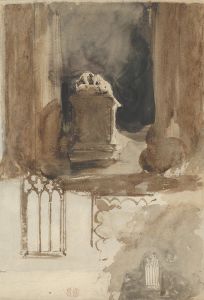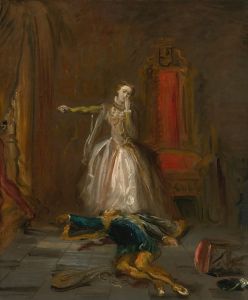
The Queen attempts to console Hamlet
A hand-painted replica of Eugène Delacroix’s masterpiece The Queen attempts to console Hamlet, meticulously crafted by professional artists to capture the true essence of the original. Each piece is created with museum-quality canvas and rare mineral pigments, carefully painted by experienced artists with delicate brushstrokes and rich, layered colors to perfectly recreate the texture of the original artwork. Unlike machine-printed reproductions, this hand-painted version brings the painting to life, infused with the artist’s emotions and skill in every stroke. Whether for personal collection or home decoration, it instantly elevates the artistic atmosphere of any space.
Eugène Delacroix's painting "The Queen attempts to console Hamlet" is an evocative work that captures a poignant moment from William Shakespeare's iconic tragedy, "Hamlet." Delacroix, a leading figure of the Romantic movement in art, was known for his dynamic compositions and expressive use of color, which are evident in this particular piece.
The painting depicts a scene from Act III, Scene IV of "Hamlet," often referred to as the "closet scene." In this scene, Queen Gertrude, Hamlet's mother, attempts to console her son, Hamlet, who is deeply troubled by the recent events in the Danish court, including the death of his father and the hasty remarriage of his mother to his uncle, Claudius. Delacroix captures the emotional intensity of this moment, highlighting the complex relationship between mother and son.
Delacroix's interest in Shakespeare's works was part of a broader 19th-century fascination with the Bard's plays, which were seen as rich sources of dramatic and emotional content. Delacroix himself was deeply inspired by literature and often drew upon literary themes in his artwork. His interpretation of Shakespearean scenes was not merely illustrative but sought to convey the psychological depth and emotional turmoil of the characters.
In "The Queen attempts to console Hamlet," Delacroix employs his characteristic style, marked by vigorous brushwork and a vivid color palette. The figures of Hamlet and Gertrude are rendered with a sense of immediacy and tension. Hamlet's expression and posture convey his inner conflict and anguish, while Gertrude's demeanor reflects her concern and maternal instinct. The use of light and shadow in the painting enhances the dramatic effect, drawing the viewer's attention to the central figures and their interaction.
Delacroix's depiction of this scene is notable for its focus on the emotional and psychological dimensions of the characters, rather than on the broader political and existential themes of the play. This approach aligns with the Romantic emphasis on individual experience and emotion, which was a defining characteristic of Delacroix's work.
The painting is part of a series of works by Delacroix that explore themes from "Hamlet." These works demonstrate Delacroix's deep engagement with Shakespearean drama and his ability to translate its complex emotional landscapes into visual form. Delacroix's "Hamlet" series is considered an important contribution to the Romantic interpretation of Shakespeare and reflects the broader cultural interest in the playwright during the 19th century.
Today, "The Queen attempts to console Hamlet" is appreciated not only for its artistic merit but also for its insight into the Romantic era's interpretation of Shakespeare. Delacroix's ability to capture the essence of Shakespeare's characters and their emotional struggles continues to resonate with audiences, making this painting a significant work in the history of art.


















